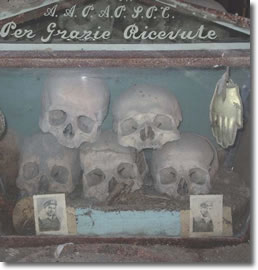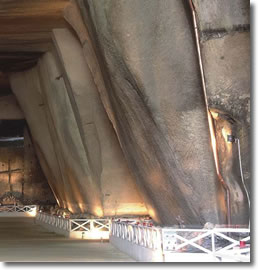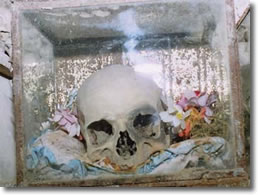Warning! The template for this page [MaggioDeiMonumenti.html] doesn't exists.
Fontanelle's cemetery: the anecdotes

- le "anime pezzentelle"
Purgatory's souls worship - Pezzentelle souls
In a document written by the canon and archaeologist Andrea De Jorio there is a reference to the transformation of the caves in a place of cult, which happened about 1700.
From the mid of 1800, a group of plebeian women from rione Sanità (called "è maste") putted in order all the remains scattered in the caves. All the bones had been putted in a sort of "popular pietas"close to the walls, following accurate groupings. This arrangement had been commemorated by a gravestone out of the church of Maria S.S. Del Carmine which had been realized at the end of XIX century; it aims to commemorate people who died,because of the pestilence, in state of absolute poverty or in prison and so, their remains are "anonymous".
The faithful had been guided by the canon Gaetano Barbati in this arrangement of the remains.
He was the founding father and promoter of a Pious work for the homage to "souls in pain".
In March, Fontanelle's cemetery had been opened to the public and the keys had been given to the parish priest of Materdei. Thanks to Barbati and the cardinal Sisto Riario Sforza it had been realized a work of homage to the deceased of that cemetery.
On 13 May 1877 it had been celebrated in the cemetery, the first religious ceremony at the presence of the cardinal Sforza, who took part in the procession following the ceremony.

- un ingresso al cimitero delle fontanelle
Since 1884 the Neapolitan "popular pietas" has been addressing to"anonymous bones and skulls" through a cult which recalls Pagan traditions.
The faithful took care of the souls in pain warranting them the so called "refrisco". This "refreshment" would be returned with the protection of the faithful by the souls.
Neapolitan people began to express their devotion for a different kind of sanctity.
The devotion,driven to the adoption of the skull and the use of votive pictures or messages introduce into the reliquaries, expressed a balance between saints worship and the popular devotion for the souls. There are many devotional urns in the cemetery; they represent the worshippers' thanks to the graces they have had by the intercession of the souls.
The "maste" (plebeian women who were very devoted to the souls) helped people to find souls who needed a lot of care and prayers.
The following text is one of the "giaculatorie e litanie" for the souls in pain:
Anime sante, anime purganti,
Io son sola e vuie siete tante
Andate avanti al mio Signore
e raccontateci tutti i miei dolori
Prima che s'oscura questa santa giornata
da Dio voglio essere consolata.
Pietoso mio Dio col sangue Tuo redento
a tutte le anime del Purgatorio salutammelle a tutti i momenti,
Eterno Riposo
Legends

- teschio del capitano con "l'occhio nero"
In such a suggestive and magic place it seems to be obvious the rise of personifications of the pezzentelle souls.
For example, Lucia, a young lady who died before her marriage or, presences of men died in war, princesses and knights.
Sometimes, the skulls have a own name and story which have been spread through tales;
this is the case of the "monk" (or capa e Pascale) who makes people know the winning numbers of the Lotto; the figure of the "captain" or that of "donna Concetta" (known as "a capa che suda").
Other important legends are linked to stories of children, in particular the story of "Pasqualino"
"Io ero ciò che tu sei; tu sarai ciò che io sono"
La Morte
The adoption of a skull is a very suggestive experience; the skulls were placed in reliquaries and the faithful venerated them, so, a lot of stories arose from this experience, for example,the skulls who sweat a and the Captain.
This skull had been adopted by a poor girl; she addressed him all the prayers, taking care of him and begging him for meeting a husband. She met a husband and before her marriage, she wanted to thank the skull for the grace. During the marriage, in the church there was a strange man dresses as a Spanish soldier; this man smiled at the bride and gave her a wink. The jealous bridegroom confronted that man and pummelled him.
After the young woman had came back from the honeymoon, she went to the cemetery to thank again her skull and, she noticed that the skull had a black eye socket. It was considered a miracle an the skull was called "Captain's skull".
Other miracles had been credited with him.
Some messages which have been found in the skulls:
Anima bella venitemi in sogno e fatemi sapere come vi chiamate.
Fatemi la grazia di farmi uscire la mia serie della cartella
Nazionale. Anima bella fatemi questa grazia, a buon rendere...
Napoli 3/4/1944
La famiglia dell'Aviere Lista Ciro trovandosi senza notizie di suo figlio da pochi
giorni dopo l'Armistizio e quindi sono otto mesi ed essendo devota di voi aspetta
con tanta fede da voi la bella grazia.


